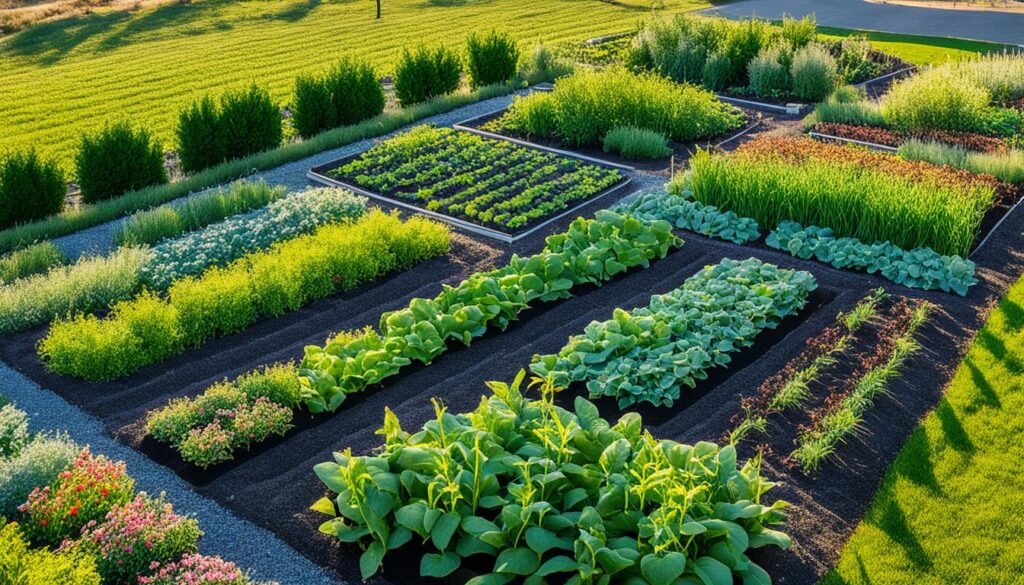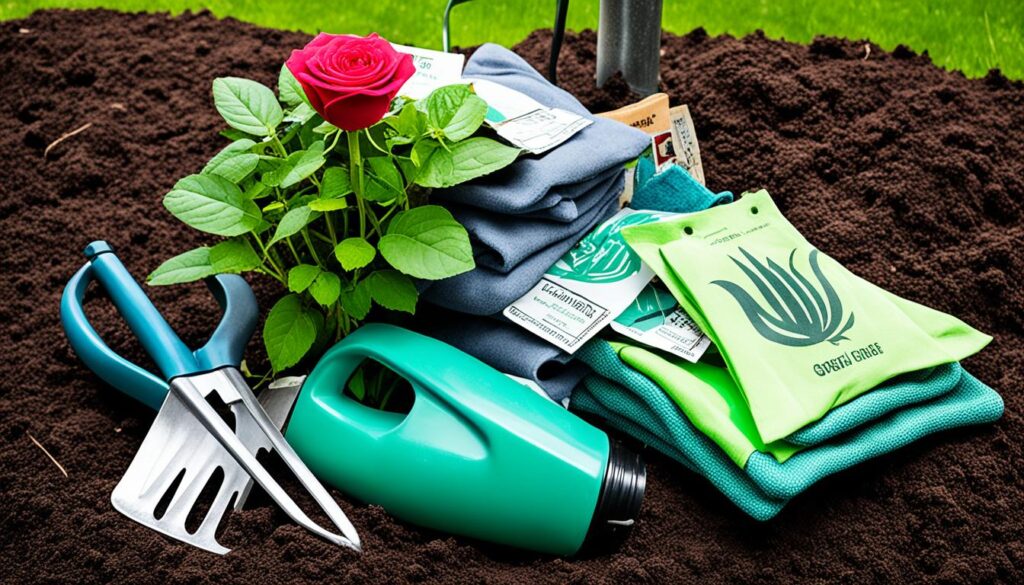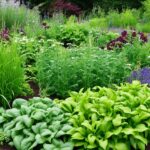How to Create a No-Till Garden
Imagine a garden that grows well without tilling or disturbing the soil. It needs less time and effort but still gives lots of fresh, healthy food. Welcome to no-till gardening, a way to grow food that’s good for the planet. But what makes it so special?
Key Takeaways
- No-till gardening is a sustainable method that minimizes soil disturbance and enhances soil health.
- It requires less time and effort, making it an ideal choice for busy gardeners.
- No-till gardening helps retain moisture, suppress weeds, and improve soil fertility through the use of mulch and compost.
- This approach mimics natural ecosystems, creating a thriving, low-maintenance garden.
- By understanding the benefits and methods of no-till gardening, you can transform your outdoor space into a flourishing, eco-friendly oasis.
Understanding No-Till Gardening
Imagine a garden that grows well without the need for constant tilling. No-till gardening is all about this idea. It skips using machines or shovels to disturb the soil. Instead, it adds organic material on top of the soil every year. This helps plants grow better.
What is No-Till Gardening?
No-till gardening is a way to keep the soil healthy and fertile without tilling. It keeps the soil’s structure good and helps plants grow better. This method also helps with carbon sequestration, brings in earthworms, and makes the soil easier for roots to spread out. It helps with water retention, keeps weeds down, and prevents erosion.
Benefits of No-Till Gardening
The main advantages of no-till gardening are:
- Better soil health and fertility
- More water retention and less erosion
- More carbon sequestration and less greenhouse gas
- Less weed suppression and less work
Using this gardening method makes your garden healthy and easy to care for. It works well with nature, supports sustainable gardening, and gives you lots of food.
Popular No-Till Gardening Methods
If you’re looking into no-till gardening, there are several methods to try. Charles Dowding’s no-dig gardening and Paul Gautschi’s Back to Eden method are popular. They offer unique benefits for different gardening styles.
No-Dig Gardening
No-dig gardening uses cardboard to stop weeds and adds compost yearly to improve soil. This method skips tilling, which can harm soil structure and its tiny life. By not disturbing the soil, gardeners create rich, healthy soil for plants.
Back to Eden Method
Paul Gautschi created the Back to Eden method. It uses wood chips as mulch that breaks down into soil. This method copies nature, where leaves and organic matter make fertile soil. The mulch stops weeds, keeps soil moist, and helps good soil life.
Ruth Stout’s No-Work Garden
Ruth Stout’s method uses hay or straw as mulch. Adding layers of this material builds nutrient-rich soil without digging. This mulch keeps soil moist, kills weeds, and helps earthworms and other creatures.
These no-till gardening methods let you pick what works best for you. Whether it’s no-dig, Back to Eden, or Ruth Stout’s method, you can have healthy soil easily. You won’t need to till the soil.
Selecting the Right Location
Choosing the right spot for a no-till garden is key to its success. Look for a place with plenty of sunlight exposure. Some plants prefer partial shade to avoid the hottest sun. A flat terrain helps water spread evenly, and being close to a water source makes upkeep easy.
Think about these important points when picking the best spot for your garden:
- Sunlight Exposure: Pick a spot that gets at least 6 hours of direct sunlight daily. Some plants do well in partial shade too.
- Flat Terrain: A flat area means water spreads evenly and prevents water from pooling or draining poorly.
- Water Accessibility: Being close to a hose or other water source makes caring for your garden easier.
- Soil Quality: Choose soil that’s rich in nutrients and drains well to support your garden’s growth.
By picking the right garden location, you’re setting up for a garden that’s easy to maintain and full of produce year after year.
Choosing the Best No-Till Method
When picking a no-till gardening method, think about your climate, the crops you want to grow, and how you’ll control weeds and retain moisture. Also, consider the cost, your long-term goals, and the look you want for your garden. These factors help pick the best no-till method for you.
Some no-till methods, like the Back to Eden or Ruth Stout methods, work better in certain climates or for specific crops. By looking at these factors, you can pick a method that fits your gardening goals and vision.
Factors to Consider
- Climate: Knowing your local climate and how it affects plants is key when choosing a no-till method. Some methods are better at handling moisture or climate challenges.
- Crop Selection: The crops you grow can affect the no-till method you use. Some methods work better for certain plants or growing needs.
- Weed Control: Managing weeds well is crucial in no-till gardens. Some methods are great at keeping weeds down and gardens healthy.
- Moisture Retention: Keeping soil moist is a big plus of no-till gardening. Look at how different methods handle moisture to pick the best one for your climate and watering needs.
- Cost: The cost to start and keep up a no-till garden varies. Think about your budget and how each method compares in cost over time.
- Long-Term Goals: Think about what you want from your garden in the long run, like soil health or a certain look. This can help you choose the right no-till method.
- Aesthetic: How your garden looks is important to many gardeners. Some no-till methods can make your garden look more natural or tidy.
By thinking about these factors, you can pick a no-till gardening method that fits your needs, tastes, and goals. This ensures a garden that’s healthy, sustainable, and looks great.

“The key to successful no-till gardening is finding the method that works best for your specific growing conditions and goals.”
Planning Your No-Till Garden Layout
Starting your no-till garden requires careful planning. The size and shape of your beds and walkways are key. They affect how well your garden works and how much you can grow. By planning well, you can make a garden that is both beautiful and productive.
One good way to set up your garden is with 5-6 foot wide beds that are 50 feet long. Add 3 foot wide paths between them. This lets you easily reach the middle of the beds and use your space well. You might also consider square foot gardening, which breaks your beds into smaller sections for better planting.
First, draw a plan of your garden. Think about the garden bed size and walkway planning that fits your space and needs. This plan will help you use your garden space well and make your growing season successful.
“A well-planned garden layout is the foundation for a thriving no-till garden.” – Gardening Guru, Jane Doe
For a great no-till garden, balance is key. Plan your layout carefully to make sure your garden is both efficient and easy to get around in. With good planning, you can have a garden that is full of life and easy to take care of.
Gathering Supplies for No-Till Gardening
Starting your no-till gardening journey means you need the right supplies. You might be using the no-dig gardening method, the Back to Eden method, or Ruth Stout’s approach. The key materials needed are similar across all these methods.
Essential Materials
Here are the basic supplies you’ll need for no-till gardening:
- Cardboard or newspaper to keep weeds away
- High-quality compost to make the soil rich
- Mulching materials like wood chips, leaves, or rotted hay for the beds
Make sure you have more of these supplies than you think you’ll need. Full coverage of your garden beds is key for no-till gardening to work well. The exact supplies you need may change based on the method you choose.

“Preparation is the key to a successful no-till garden. Ensure you have an ample supply of the essential materials before starting your project.”
With the right no-till gardening supplies, like cardboard, compost, and mulch, you’re ready to create a garden. This garden will be healthy, easy to maintain, and will help the soil and reduce weeds.
Preparing the No-Till Garden Beds
Starting a no-till garden means getting the beds ready. It’s all about stopping weeds and adding organic matter. These steps help your plants grow well.
Suppressing Weeds and Grass
To begin, kill the weeds and grass in your garden beds. Use cardboard or newspaper to block sunlight. This stops the plants from making food and they will die.
With the weeds gone, you’re ready for a clean space to plant.
Building Organic Matter Layers
After getting rid of weeds, start adding organic layers. Put down 3-4 inches of compost first. Compost is full of nutrients that help plants grow.
Then, add a 4-6 inch layer of mulch, like wood chips or rotted hay. Mulch keeps the soil moist, stops weeds, and adds more organic matter.
“Healthy soil is the foundation for a thriving no-till garden. By taking the time to properly prepare the beds, you’re setting your plants up for success.”
By stopping weeds and adding organic layers, your garden is ready to grow. You’ve given your plants a strong start. Now, you can plant with confidence, knowing your plants will do well.
no-till gardening
No-till gardening has many benefits over traditional tilled gardens. It avoids disturbing the soil and keeps adding organic matter. This approach improves soil health, boosts plant yields, and cuts down on maintenance.
This method, which mimics nature, helps with water retention, reduces weeds, and attracts beneficial organisms like earthworms.
One big plus of no-till gardening is its effect on soil health. By not tilling, you keep the important networks and structure of the soil intact. These are key for nutrients and water to move around easily. This leads to soil that’s strong against drought, pests, and diseases.
Another big benefit is the potential for more plants. Without the damage from tilling, plants can grow better. Plus, the soil holds more moisture and nutrients, making for bigger and healthier crops.
Lastly, no-till gardening is easier to maintain. It keeps weeds down and builds up organic matter. So, you’ll spend less time on weeding, cultivating, and adding stuff to the soil. This makes it a sustainable and easy way to grow a garden full of vegetables or flowers.
| Benefit | Description |
|---|---|
| Improved Soil Health | Preserves soil structure and mycorrhizal networks, leading to better nutrient cycling and water absorption. |
| Higher Plant Yields | Allows plants to focus on growth rather than repairing root damage, with increased moisture and nutrients. |
| Reduced Maintenance | Suppresses weeds and maintains organic matter, requiring less time and effort on tasks like weeding and cultivating. |
By using no-till gardening, you can make a garden that’s full of life and needs little upkeep. It feeds the soil and helps a wide variety of helpful organisms. The payoff is big harvests and a garden that’s strong and healthy.
Planting in Your No-Till Garden
Planting in a no-till garden needs some special steps to help your seeds and plants grow well. By using the best methods, you can make your garden successful for a long time.
Planting Seeds
When you plant seeds, move the mulch aside first. This lets seeds like carrots grow well by touching the soil. Once they sprout, put the mulch back, but don’t cover the young plants too much.
Planting Starts and Transplants
Before moving seedlings, loosen their roots to stop them from being too tight. Plant them at the same level as before, but don’t cover them too deep. After moving, put mulch back around the plants, but not on the leaves.
Good planting habits and careful attention will make your no-till garden flourish. By following these tips, you’ll give your seeds, seedlings, and transplants a great start in your garden.
Conclusion
No-till gardening is a great way to grow a garden that’s both sustainable and easy to care for. It doesn’t disturb the soil and keeps adding organic stuff to it. This makes the soil healthier, helps plants grow better, and means you don’t have to work as hard.
Choosing the no-dig, Back to Eden, or Ruth Stout method is important. The goal is to make your garden act like nature does. This helps plants grow the best they can.
With the right spot, plan, and setup, you can have a no-till garden that’s a success. Using sustainable gardening and organic ways, you’ll have a garden that’s easy to keep up and lasts a long time.
This article has given you the tips you need to make your garden a place that takes care of itself and the earth. Start no-till gardening and see how amazing your garden can become.
FAQ
What is no-till gardening?
What are the benefits of no-till gardening?
What are some popular no-till gardening methods?
How do I choose the right location for a no-till garden?
What should I consider when choosing a no-till gardening method?
How do I plan the layout of my no-till garden?
What supplies do I need to get started with no-till gardening?
How do I prepare the no-till garden beds?
What are the benefits of no-till gardening compared to traditional tilled gardens?
How do I plant in a no-till garden?
Source Links
- https://sunshinefarmny.com/2021/05/11/how-to-start-a-no-till-garden-from-scratch/ – How to Start a No-Till Garden from Scratch
- https://northernhomestead.com/starting-a-new-no-till-garden-with-tilling/ – Starting a new no-till garden with tilling
- https://rootsandrefuge.com/no-till-gardening-the-various-methods/ – No-Till Gardening (The Various Methods)
- 10 Must-Have Blooms for Your 2025 Garden
- The Health Advantages of Gardening You Need to Know
- How to Create a Small Vegetable Garden Layout Plan: A Beginner’s Guide
- DIY Garden Projects for Small Spaces: Upcycling Ideas to Maximize Your Garden
- Watering Techniques for Small Gardens: Ensuring Your Plants Thrive
- Small Border Plants for Landscaping: Adding Beauty and Functionality to Your Garden
- Year-Round Small Space Gardening: Seasonal Planting Tips for Maximum Harvest
- Essential Tools for Small-Space Gardening: What You Really Need
- The Ultimate Guide to Container Vegetables: What to Grow in Small Spaces
- Budget-Friendly Gardening: How to Create a Thriving Garden on a Tight Budget
- How to Optimize Sunlight in Small Gardens: Tips for Better Plant Growth
- DIY Vertical Planters: Creative Ideas for Small Space Gardening
- Companion Planting for Small Vegetable Gardens: Boost Growth and Deter Pests
- Container Gardening Essentials: Choosing the Right Pots, Soil, and Plants
- Vertical Gardening Techniques: Maximizing Your Small Space with Climbers and Vines
- How to Build a Raised Bed Garden in a Small Backyard: Step-by-Step Guide
- The Best Vegetables for Small-Space Gardens: High-Yield Varieties You Need to Grow
- Smart Vegetable Garden Layouts for Small Spaces: Maximizing Your Green Thumb in Compact Areas
- 40. Best Practices for Managing a Sustainable Garden Year-Round
- Building a Wildlife Pond for Biodiversity
- Advanced Techniques in Sustainable Gardening
- How to Create a No-Till Garden
- The Mental Health Benefits of Gardening
- Using Technology to Enhance Sustainable Gardening
- Getting Certified Organic: Steps and Benefits

Leave a Reply